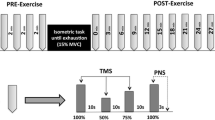Abstract
Local muscle fatigue can originate from both peripheral and central factors. The relative contribution of these factors in the course of a fatiguing contraction in 20 healthy subjects was determined. While subjects made a 2-min sustained maximal voluntary contraction (MVC) of the biceps brachii, muscle fibre conduction velocity (MFCV) was determined with surface electromyography (SEMG) as a representation of developing peripheral fatigue. To quantify the amount of peripheral fatigue, the force development following a train of electrical stimuli on the endplate before and after the contraction were compared. To measure force loss caused by central factors, superimposed electrical stimulation was used during the contraction. By two different methods the influence of peripheral fatigue on the superimposed force responses was taken into account. The first method compared the force response with the actual voluntary force, the second –which seemed more valid – used an estimation of peripheral fatigue based on linear interpolation between the force responses during rest before and after sustained contraction. During the contraction, voluntary force decreased to 38%. Peripheral fatigue was responsible for the larger part of this decline (89%). The other part, which was calculated as 12%, was caused by an increase of central activation failure. The decline of MFCV indicated that peripheral fatigue increased predominantly during the first half of the contraction and stayed at a constant level during the latter part. In contrast, central fatigue mainly induced a force decrease in the second part of the contraction. The different mechanisms which could be responsible for this change of emphasis from peripheral to central factors are discussed.



Similar content being viewed by others
References
Allen GM, Gandevia SC, McKenzie DK (1995) Reliability of measurements of muscle strength and voluntary activation using twitch interpolation. Muscle Nerve 18:593–600
Bigland-Ritchie B, Johansson R, Lippold OCJ, Smith S, Woods JJ (1983) Changes in motoneurone firing rates during sustained maximal voluntary contractions. J Physiol (Lond) 340:335–346
Brody LR, Pollock MT, Roy SH, De Luca CJ, Celli B (1991) pH-induced effects on median frequency and conduction velocity of the myoelectric signal. J Appl Physiol Nov 71(5):1878–1885
De Luca CJ (1984) Myoelectrical manifestations of localized muscular fatigue in humans. Crit Rev Biomed Eng 11(4):251–279
Gandevia SC (1998) Neural control in human muscle fatigue: changes in muscle afferents, motoneurones and motor cortical drive. Acta Physiol Scand 162:275–283
Gandevia SC (2001) Spinal and supraspinal factors in human muscle fatigue. Physiol Rev 81(4):1725–1789
Gandevia SC, Allen GM, Butler JE, Taylor JL (1996) Supraspinal factors in human muscle fatigue: evidence for a suboptimal output from the motor cortex. J Physiol (Lond) 490:529–536
Gandevia SC, Herbert RDo, Leeper JB (1998) Voluntary activation of human elbow flexor muscles during maximal concentric contractions. J Physiol (Lond) 512:595–602
Houtman CJ, Heerschap A, Zwarts MJ, Stegeman DF (2001) pH heterogeneity in tibial anterior muscle during isometric activity studied by (31)P-NMR spectroscopy. J Appl Physiol 91(1):191–200
Kent-Braun JA (1999) Central and peripheral contributions to muscle fatigue in humans during sustained maximal effort. Eur J Appl Physiol 80:57–63
Kent-Braun JA, LeBlanc R (1996) Quantitation of central activation failure during maximal voluntary contractions in humans. Muscle Nerve 19:861–869
Kirkendall DT (1990) Mechanisms of peripheral fatigue. Med Sci Sports Exerc 22:444–449
Kranz H, Cassell JF, Inbar GF (1985) Relation between electromyogram and force in fatigue. J Appl Physiol 59(3):821–825
Linssen WHJP, Jacobs M, Stegeman DF, Joosten EMG, Moleman J (1990) Muscle fatigue in McArdle's disease. Brain 113:1779–1793
Linssen WHJP, Stegeman DF, Joosten EMG, van 't Hof MA, Binkhorst RA, Notermans SLH (1993) Variability and interrelationships of surface EMG parameters during local muscle fatigue. Muscle Nerve 16:849–856
Lloyd AR, Gandevia SC, Hales JP (1991) Muscle performance, voluntary activation, twitch properties and perceived effort in normal subjects and patients with the chronic fatigue syndrome. Brain 114:85–98
Masuda K, Masuda T, Sadoyama T, Inaki M, Katsuta S (1999) Changes in surface EMG parameters during static and dynamic fatiguing contractions. J Electromyogr Kinesiol 9(1):39–46
Merton PA (1954) Voluntary strength and fatigue. J Physiol (Lond) 123:553–564
Moritani T, Muro M, Nagata A (1986) Intramuscular and surface electromyogram changes during muscle fatigue. J Appl Physiol 60(4):1179–1185
Naeije M, Zorn H (1983) Estimation of the action potential conduction velocity in human skeletal muscle using the surface EMG cross-correlation technique. Electromyogr Clin Neurophysiol 23:73–80
Stegeman DF, Linssen WHJP (1992) Muscle fiber action potential changes and surface EMG: a simulation study. J Electromyogr Kinesiol 2(3):130–140
Thomas CK, Woods JJ, Bigland-Ritchie B (1989) Impulse propagation and muscle activation in long maximal voluntary contractions. J Appl Physiol 67(5):1835–1842
Zwarts MJ, Arendt-Nielsen L (1988) The influence of force and circulation on average muscle fibre conduction velocity during local muscle fatigue. Eur J Appl Physiol 58:278–283
Zwarts MJ, Van Weerden TW, Links TP, Haenen HTM, Oosterhuis HJGH (1988) The muscle fiber conduction velocity and power spectra in familial hypokalemic periodic paralysis. Muscle Nerve 11:166–173
Acknowledgements
The authors would like to thank all participants who volunteered for this study. Furthermore, we thank Hans van Dijk for technical support and Henny Janssen and Jeannine Hermens for their contributions to the performance of the measurements. This study was supported by a grant from Prinses Beatrix Fonds (grant no. MAR00–121). All experiments complied with the current laws for human studies.
Author information
Authors and Affiliations
Corresponding author
Rights and permissions
About this article
Cite this article
Schillings, M.L., Hoefsloot, W., Stegeman, D.F. et al. Relative contributions of central and peripheral factors to fatigue during a maximal sustained effort. Eur J Appl Physiol 90, 562–568 (2003). https://doi.org/10.1007/s00421-003-0913-4
Accepted:
Published:
Issue Date:
DOI: https://doi.org/10.1007/s00421-003-0913-4




